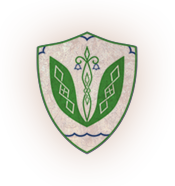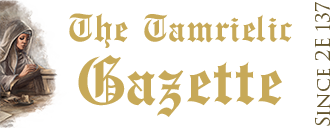Jehanna: Lifelines
By: Madura Dalas, 4E 204Recent history of the Kingdom of Jehanna The royal crest of the Kingdom of Jehanna, created in 3E 400
The royal crest of the Kingdom of Jehanna, created in 3E 400Jehanna is perhaps the youngest city in High Rock. It is nothing more than a seasonal dock during the Interregnum of the second era, hosting occasional ships bringing supply to the then Wrothgarian Orsinium. Historical records suggest that this first sign of civilization is contemporary with the Daggerfall Covenant. However, further research into Reachmen oral traditions hints toward even earlier use, of what is now Jehanna, by fishers from the Krohn tribe. Some scholars connect the Krohn, whose lineage is now carried by several Reachmen tribes, to the Ice Tribes of the third era Pale. Personally, I cannot confirm this speculation with any certainty. There are also theories about the Ice Tribe being Falmers, Rieklings or even Kamals. Whatever they are, the Ice Tribe is now gone and outside the scope of this article, but for those interested, I will be publishing a detailed examination next year.
Known as the Bone City, for the massive mammoth graveyards just outside of it, and various bone constructs decorating its structures, the urban layout and its architecture makes Jehanna's origin firmly Nordic. Historians believe the first permanent settlement there is built by Nord traders in the late second era; they ran an unassuming town until Tiber Septim's conquest incorporated it into the province of High Rock.
For what it matters, Jehanna is Breton at the start of the fourth era, the result of Imperial arbitration following the War of Bend'r-mahk. Just prior to the Great War, Imperial census split the population into two-third Breton and one-third Nord. The validity of this census is under much scrutiny. Some say this ratio is reversed, but the balance of power is not. Before the Great War, the ruling family is devoid of Nordic lineage. The Ervette dynasty was awarded rulership of Jehanna by Uriel Septim VII, but detailed documentations are destroyed in a fire. They trace their ancestors to the merchant lords of Wayrest, and going as far as claiming descendence from High King Emeric himself. Like many Breton dynasties, the Ervettes are well connected to Imperial City, with favors apparent since the late third era and continuing well into the Mede dynasty. But unlike many Breton monarchies, the Ervettes pride on keeping their lineage pure, marrying their cousins instead of distant nobles. Some Ervette heirs pledge their life to the Order of the Ice Blade (a knightly order), to cultivate their martial prowess.
In the greater Kingdom of Jehanna, the Bone City itself is joined by its vassals; Farrun and Morkul.
Farrun County enjoys a degree of autonomy, and is ruled by its own count. This city is older, with evidence pointing to an Orcish stronghold called Fharun, predating even the first Orsinium. In the fourth era, Farrun is slightly smaller than Jehanna, though both are port cities located on the same latitude (comparable to Dawnstar). Because northern High Rock's trade come primarily through Skyrim and Morrowind (the south uses Illiac Bay and trade with Hammerfell), Farrun's distance from the east and its shallower harbor makes it less prosperous than Jehanna. The ruling family in Farrun changed midway through the fourth era, however, both are Breton and deriving their ancestry from Shornhelm. Farrun occasionally disputed with Jehanna, and perhaps the change of leadership is dictated by the Ervettes. The details are suspiciously scarce, but the result is apparent. Whatever rebellion could have happened is snuffed out in its infancy.
Morkul is an Orc stronghold; perhaps the only one in history loyal to non-Orcish rulers. Its people observe a mix of Malacath's code and Breton social conventions. The chieftain of Morkul is officially titled the Count of Morkul, his wives are the countesses of Morkul, though only one bears his children and the rest serve as his advisers. The history of Morkul goes back to Orsinium's sacking after the Daggerfall Covenant. The chieftain aggressively engaged the Bretons, and was slain early. His forge-wife, shrewd in diplomacy and familiar with Breton customs, offered their allegiance in exchange for their survival. This alliance continues to the present day, for the rangers and smiths of Morkul have few equals among Breton realms.
Morkul is also home one of the last few echateres left on Tamriel. Having been hunted to near-extinction during the early third era, a few dozen remain, thanks to an enduring breeding program in Morkul. The echateres are the traditional pack animals of the Orcs. They are occasionally lent out to circus and zoo shows.
The empire projects its presence in the area through the former 21
st legion (now the 11
th legion), which is also known as the Northern High Rock Auxiliary or the Jehanna Legion. However, recruitment and command are delegated to the Kingdom of Jehanna, and unless a major war or crisis requires its service, the legion at Jehanna is effectively an extension of the local guards. Between the Oblivion Crisis and the Great War, the Jehanna Legion did exactly that. Under "Empire-wide mandates", the legion acts above the very law their guard counterparts upholds, meaning they are the perfect secret police for crushing dissidence and political enemies. Their ranks become increasingly Breton-dominated, and their "justice" often target the Nords.
For the first 171 years of the second era, the above is the status quo. Bretons rule Jehanna with Orcs at their side. The Nords are the foundations for what used to be, yet, they are voiceless for what will come. Status quo exists to be broken, and the Great War broke many things.
When the Great War breaks out, the empire mobilizes all auxiliary legions across its territories. The Jehanna Legion, commanded by King Rowland Ervette of Jehanna, is initially posted along western High Rock. However, the sacking of Imperial City put the Jehanna Legion into combat duty. Eager to demonstrate his loyalty to the Emperor, King Rowland introduces conscription and volunteers his troops for the Battle of the Red Ring. Rowland takes the western flank as part of a pincer maneuver, where his legion prevented a Dominion breakout and destroyed several enemy units. In the process, the Jehanna legion, spirited but inexperienced, takes heavy casualties, including the king himself.
Medals, recognitions and memorials cannot undo the cost of war. After the signing of the White-Gold Concordat, Queen Emerwyn Ervette, the widow of King Rowland, finds herself with a kingdom coming apart at the seams. During the course of the war, commitments to the frontlines drain the local guards of their ability to patrol. The Wrothgarian Road, a vital route connecting the Illiac Bay to the Sea of Ghosts, and the lifeline of Jehanna's trade, falls neglect. Filling the vacuum are the neo-Krohnian Reachman tribes. They raid and pillage without consequence, to the point where even the most cautious convoys are picked off clean. Reachmen effectively rule the wilderness between major settlements. Fear clouds over the entire kingdom; with no sufficient fighting force present, Queen Emerwyn declares the Wrothgarian Road closed.
The winter of 174 is a cold one, and it is also the worst for Jehanna in a very long time. Lack of trade convoys means vital food supply from the south are cut off. Famine spread and the people become frustrated. The Orcs at Morkul suffer the most. Due to their distance from Farrun and Jehanna, their sustenance are few, and the Reachmen raids are more frequent. Yet, the Orcs persevere, fending off the cold with the flames of growing hatred in their hearts. There is an old saying in the region: "Whoever holds the Orcs' loyalty holds the key to the castle". When 175 comes, the Orcs' loyalty is slipping away from Jehanna.
No one knows exactly why the Nords came, but they welcome them regardless. Frithjolf, a thane of Haafingar and one of Ulfric Stormcloak's lieutenants, marched through Dunlain Falls with several hundred Nord warriors in tow. It is now 176, and when the Nords arrive in Jehanna, blood of Reachmen fresh on their shields, Queen Emerwyn is mourning her late husband. Frithjolf claims he comes with the intention of "helping his brothers and sisters in the west", his duty, because his ancestors "once protected the land". The Nords in the city cheer (and so do the Orcs at Morkul, when the news reached them). Emerwyn cannot deny their results, for Frithjolf's forces is reclaiming more lands in weeks than she had in the last year. The Nords are officially made the Kingdom's militia, and they begin recruiting from the populace (much of the recruits are disenfranchised local-born Nords). By the end of the year, the militia is eclipsing the official guard force.
Normally, the Ervettes would use the Jehanna Legion and its Imperial sanction to break up threats to their power. But all auxiliary legions have been reorganized and their commands centralized to Cyrodiil (in order to reinforce regular legions). Therefore, Emerwyn has no army of her own when Frithjolf issues his challenge.
And challenge he does. As Emerwyn declares a week of mourning at the start of 177, Frithjolf openly rejects the motion and claims the queen no longer fit to rule. He offers her an adviser position, but Emerwyn will accept nothing besides Frithjolf's departure. This causes Frithjolf to invoke the Combat of the Thirty, an ancient tradition on both side of Reach (that may have originated with the first Orsinium), where contenders to the throne bring their finest and fight until one leader falls.
Emerwyn and her inner circle laughs off the challenge, but her people do not laugh. They want change; they want blood.
So Emerwyn has no choice but to face Frithjolf in battle. In all fairness, she is a skilled warrior in her own right. Emerwyn studied with the Order of the Ice Blade in her youth, and honed her skills leading counterattacks against the Reachmen. Face to face in combat, it is Emerwyn that has the upper hand. Her superior footwork and precise sword strikes overcoming Frithjolf's brute force axe and shield attacks. Soon, she has him on the ground, shield shattered and the arm holding it severed below the elbow. It is at this moment when Emerwyn's overconfidence got the better of her. She turns to ask the crowd to remember the traitor's death, and when she turns back, Frithjolf hurls a hidden dagger into her left eye.
Emerwyn's champions stop upon their queen's death. Some kneel and pledge their fealty to Frithjolf, while other shake their head and run. Most of the onlookers applaud Frithjolf, though a few of skulk away in defeat. One of them is the young Alanis Ervette, daughter of Emerwyn and (no longer) the crown princess of Jehanna. Alanis is just old enough to understand mortality, and she realizes quickly that she is orphaned. A knight loyal to the Ervettes takes Alanis' hand and flee from the kingdom. Frithjolf let them leave, telling his people that the old monarchs are gone, and it is now the start of a new age.
Frithjolf takes the Name
Broken-Shield. It originates from residual loyalists mocking his near death against Emerwyn, and the fact that his left hand no longer exists. He takes the Name in stride, though, as it shows his humbleness and serves as a reminder of his near failure. The now King Frithjolf Broken-Shield marries Lady Idunn of Markarth, his comrade during Ulfric's Reach campaign. They would have three children in the years to come; two princes and a princess.
The years from 177 up to the Skyrim civil war at 201 are over two decades of profound change, at least relative to the prior years of the era. Formerly neglected Nords rise from their slums to take control of the most profitable businesses. Some of these High Rock-born Nords manage to earn their place in Jehanna's royal court, where they usher in a renaissance of western Nordic culture; revival of insular Nordic art in Breton galleries, bards from Solitude performing at local taverns and residents proudly showcasing the Nordic heritage of their city to (the scant amount of) tourists. Many Bretons leave the Kingdom at first, but when they realize that Frithjolf brings a better trade outlook with Skyrim, they flock back with eager goods in hand. The Morkul Orcs find themselves disappointed with the new monarch, as closer integration never occurred and Frithjolf's commanders frequently ignore Morkul rangers. The reception from other High Rock realms is icy at first. Some see Frithjolf's ascension as a revival of Nordic expansionist ambitions, while others fear a replay of the War of Bend'r-mahk. Eventually, Frithjolf's diplomacy (more direct than what Breton monarchs liked, but cordial nonetheless) and the common threat of Corsairs in Wayrest manage to bring Jehanna back in communion with its peers. Perhaps the military of Jehanna has something do with it; by 200, it is on par with Camlorn, and second only to Daggerfall.
The civil war in Skyrim changes surprisingly little in Jehanna. Loud voices in the city urge for supporting the Stormcloaks, while some rulers on the Illiac want to help out the legion. King Frithjolf remains firmly neutral, and even shutting off arms shipment when the war heats up, though it does not stop volunteers from flooding over the border. Declining trade with Skyrim signals a hard time ahead, but the kingdom's economy endures. Farrun gets hit the hardest, and when Frithjolf refuses to acknowledge her concerns, the Countess of Farrun (the cousin of Emerwyn Ervette) abdicates and takes her knights to join General Tullius at Solitude. It suits Frithjolf just fine, to have the last trace of the Ervettes gone, clearing the way to install his son as the ruler of Farrun.
Nobody expects the Dragonborn to suddenly become the high king of Skyrim, Jehanna included. Skyrim and the rest of the world start off 202 as enemies; it is a political state Frithjolf knows better than anyone else. Sooner or later, a bigger threat will pop up and former enemies will band together to counter it. So it is him that first send envoys to the Dragonborn, when news of the Nerevarine spread from Morrowind. It is Frithjolf that convinces the Dragonborn to keep the East Empire Company around and reestablish diplomacy and commerce with High Rock. Perhaps other High Rock leaders should thank him for defusing a potential invasion from the east, but all the reward Frithjolf needs is seeing prosperity returning to his impoverished kingdom.
But where does this leave the exiled Jehannian Bretons, and some of our sharp readers may ask: "what happened to the last Ervette?" Well, my good friends, let me tell you that I just had the pleasure of interviewing Alanis Ervette herself in Daggerfall last month. I can say that she is a delightful host and has the most impeccable taste in escargot. Her personal journey and career is equally impressive as her etiquette. Sir Geniston, former knight in the Order of the Ice Blade, raised her as his step-daughter. They fled to Daggerfall in 178, where King Bellemont of Daggerfall granted them asylum out of sympathy. Sir Geniston raised Alanis like his own child; a warrior.
"He is a kind man, but make no mistake, my step-father pushed me to be my very best." Alanis told me.
Indeed, Alanis joined the Knights of the Dragon when she came of age. Her loss and hardship burned away her contentment, and the teachings of Sir Geniston forged her into a fighter. She served the knightly order with distinction, having defeated numerous bandits, goblins and vampires. She came to our interview wearing the prized mithril alloy plates of a dame-commander, decorated with battle honors.
When I asked Dame Ervette about what she thinks of Jehanna, and what are her personal plans going ahead, she had the following to say.
"I am honored to call Daggerfall home, but Jehanna will forever be a part of me. Frithjolf Broken-Shield seized his opportunity when the moment came; I will soon seize mine."






